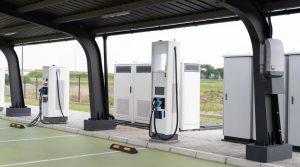As the UK steers toward a sustainable and technologically advanced future, changes in driving laws and regulations are playing a critical role in shaping this transition.
December 2024 marks the introduction of several important updates that impact company car drivers, owners of electric and traditional vehicles, heavy goods vehicle (HGV) operators, and charge point operators.
These changes are designed to enhance efficiency, reduce emissions, and modernise the UK’s road and vehicle ecosystem.
This comprehensive guide breaks down the key updates, ensuring you understand their implications.
Revised Advisory Fuel Rates (AFRs): What They Mean for You?

The HMRC’s revised Advisory Fuel Rates (AFRs), effective from December 1, 2024, bring significant changes for businesses and company car drivers.
These rates are used to reimburse employees for business travel in company cars or for the cost of fuel for private travel.
- Petrol-Powered Cars
- Engines up to 1,400cc: Reduced to 12p per mile (previously 13p).
- Engines between 1,401cc and 2,000cc: Reduced to 14p per mile (previously 15p).
- Engines over 2,000cc: Reduced to 23p per mile (previously 26p).
- Diesel-Powered Cars
- Engines up to 1,600cc: Reduced to 11p per mile (previously 12p).
- Engines between 1,601cc and 2,000cc: Reduced to 13p per mile (previously 14p).
- Engines over 2,000cc: Reduced to 17p per mile (previously 18p).
- Liquefied Petroleum Gas (LPG)
- Engines up to 1,400cc: 11p per mile (unchanged).
- Engines between 1,401cc and 2,000cc: 13p per mile (unchanged).
- Engines over 2,000cc: 21p per mile (unchanged).
- Electric Vehicles (EVs)
- Rate remains at 7p per mile, while hybrid vehicles are categorised as petrol or diesel based on their engine type.
Employers can claim VAT on these rates if employees provide fuel receipts, making it essential for businesses to stay updated on these changes.
AFRs are reviewed quarterly, reflecting fluctuations in fuel prices and improving vehicle efficiency.
Smart Tachograph 2: New Mandates for HGV Operators
Smart tachographs are critical tools for recording driving time, speed, and rest periods in HGVs and other commercial vehicles.
The latest regulations, effective December 31, 2024, require HGVs used for international journeys to install the updated Smart Tachograph 2 system.
Key updates include:
- Vehicles undertaking international journeys must retrofit either a “full” Smart Tachograph 2 or a “transitional” Smart Tachograph 2.
- Newly registered in-scope vehicles must have the updated tachograph installed from February 21, 2024, irrespective of journey type.
These changes aim to ensure compliance with EU driving time rules, which limit drivers to 9 hours per day, 56 hours per week, and 90 hours over two consecutive weeks.
Vehicles operating solely within the UK are permitted to continue using analogue or older digital tachographs.
To avoid potential disruptions, operators are advised to update their systems promptly, mainly if international travel is a routine part of their operations.
Enhancing the EV Charging Infrastructure

The UK government is taking significant strides to modernise the EV charging network.
With new standards introduced in late November 2024, the focus is on improving accessibility, reliability, and user convenience.
Critical Requirements for Charging Points:
- Contactless Payment Options: All chargers with a capacity of 8kW or above must offer contactless payment methods.
- Reliability Standards: Chargers must meet a 99% uptime benchmark, ensuring fewer disruptions for EV users.
- Accessible Data: Charging data must be made publicly available in a machine-readable format, fostering transparency.
- Support Helplines: A free 24/7 helpline is now mandatory to assist users.
Failure to meet these requirements could result in fines of up to £10,000 per non-compliant charging point. These measures aim to instil confidence among EV owners and encourage a shift away from traditional fuel vehicles.
Zero Emission Vehicle (ZEV) Mandate: Driving the Electric Transition
The ZEV mandate, effective from January 1, 2024, sets ambitious targets for car manufacturers to increase the production and sale of electric vehicles.
This initiative supports the broader goal of banning petrol and diesel car sales by 2035.
Key Targets:
- 2024: 22% of car sales and 10% of van sales must be fully electric.
- 2030: At least 80% of all cars sold must be electric.
- 2035: 100% of cars sold must produce zero emissions.
Manufacturers failing to meet these targets face fines of £15,000 per car and £9,000 per van below the target.
This policy not only incentivises automakers to innovate but also aligns with the UK’s commitment to reducing carbon emissions.
Impacts on Petrol and Diesel Vehicle Owners

The December changes also bring financial implications for traditional vehicle owners. The reduction in AFRs for petrol and diesel cars reflects increased fuel efficiency and aligns with the government’s push toward electrification.
For instance:
- A petrol car with an engine size up to 1,400cc now costs 1p less per mile to reimburse, saving businesses on expenses but signalling reduced incentives for petrol vehicle use.
- Similarly, the reimbursement rate for diesel cars with engines over 2,000cc has decreased by 1p per mile, further encouraging a shift toward eco-friendly alternatives.
These changes highlight the financial and environmental advantages of transitioning to EVs, offering long-term benefits for businesses and individual drivers.
Supporting Local Councils in Expanding EV Infrastructure
Local councils are at the forefront of developing and maintaining the EV charging network.
With over 68,000 public charge points already installed across the UK, recent regulations emphasise collaboration between councils and private entities to bridge infrastructure gaps.
Councils are focusing on:
- Upgrading existing charge points to meet the 50kW capacity requirement.
- Ensuring rural and underserved areas receive sufficient charging facilities.
These efforts aim to create a reliable and accessible charging ecosystem, building public trust and encouraging widespread EV adoption.
Financial Risks and Opportunities for Charge Point Operators

The new EV charging regulations present challenges for charge point operators (CPOs), particularly those managing extensive networks.
The potential financial exposure for non-compliance is significant, with fines reaching billions across the industry.
However, these regulations also create opportunities for investment and innovation in the EV sector.
By adhering to the updated standards, CPOs can enhance customer satisfaction, attract new users, and position themselves as leaders in the growing EV market.
Encouraging EV Sales Through Financial Incentives
The gradual increase in ZEV targets is complemented by financial incentives and penalties, ensuring automakers remain committed to electrification.
The penalties for non-compliance are designed to spur faster adoption of electric technology, fostering competition and innovation.
As the EV market grows, consumers will benefit from a broader range of affordable and efficient electric models, making the transition to zero-emission vehicles more accessible.
Conclusion
The December 2024 driving law changes reflect the UK’s proactive approach to addressing environmental challenges, modernising infrastructure, and ensuring road safety.
While these updates may pose initial challenges, they also provide opportunities for businesses and individuals to embrace sustainable practices.
From the reduced AFRs for company cars to stricter regulations for EV charging and tachographs, these changes signify a transformative period for the UK’s automotive sector.
By staying informed and adapting to these updates, motorists and businesses can not only comply with the law but also contribute to a greener and more efficient future.
As the government continues to refine policies and regulations, one thing is clear: the road ahead is electric, sustainable, and innovative. Are you ready to embrace the change?





